If the air conditioning system in Ford Flex is not blowing hard enough or has weak airflow, it not only negatively affects the cooling performance, but can also increase the fuel consumption of the vehicle as the AC system has to work much harder to maintain the desired cabin temperature.

The most common causes for Ford Flex AC not blowing hard enough are clogged cabin air filter, dirty evaporator coil, and frozen evaporator coil due to low refrigerant. Less common causes are dirty or sluggish blower motor and faulty mode door actuator.
1. Clogged cabin air filter
Dirty AC filter is the leading cause of weak AC airflow in Ford Flex. The pollen filter, also known as the cabin air filter or microfilter, is responsible for filtering the air that the passengers breathe in the cabin. A dirty filter causes the overall ventilation of the interior to deteriorate resulting in reduced cooling and airflow. It also puts unnecessary strain on the entire AC system which negatively impacts the fuel economy.
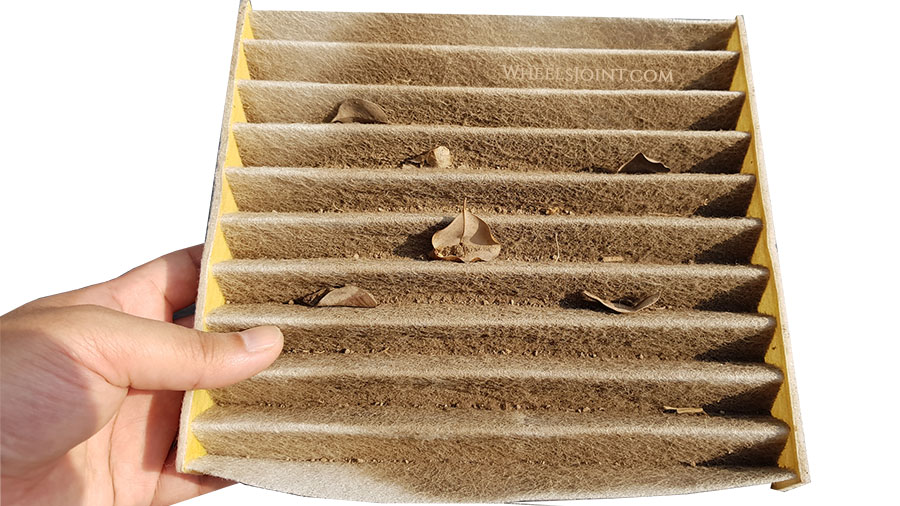
There is no prescribed time for changing cabin air filter, but most manufacturers recommend a change after 10,000-20,000 miles. If you drive your vehicle in dusty or polluted environment, the filter can get dirty much sooner than manufacturer’s recommendation.
Can you clean a dirty cabin air filter?
Instead of changing the cabin air filter in Flex, it is often recommended to first clean the filter. This can be done, for example, with a vacuum cleaner or a compressed air system, removing at least a large part of the visible dirt particles. Unfortunately, this procedure does not allow you to get into the deeper layers of the filter. Therefore, the filter performance will not increase significantly even after cleaning. As a rule, there is no avoiding a change if the filter is dirty.
Recommended video
2. Dirty evaporator
Dirty evaporator can also significantly reduce AC airflow and cooling performance in Flex. The cabin air filter captures most of the dirt or other airborne particles, but some particles escape and can get lodged on to the evaporator. Over time, these particles build up on the fins and block the airflow through the evaporator coil, causing poor airflow from AC vents and degraded cooling performance.
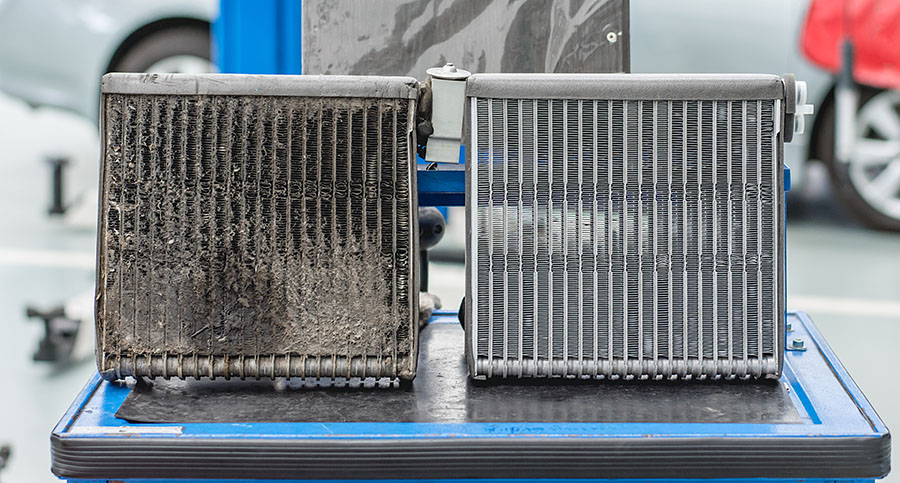
Symptoms of a dirty evaporator
The two most prominent symptoms of a clogged up evaporator in Flex are: the air flow from the AC vents is choppy and not smooth, and the inside of the vehicle is developing a bad moldy smell.
Clean the evaporator
Cleaning the evaporator in Flex is not a simple task. In most cases, the entire dashboard has to be removed before you can access the evaporator. Therefore, it is recommended to do this in a workshop.
3. Frozen evaporator
Evaporator coil freezing up due to insufficient amount of refrigerant in the AC system can cause weak airflow from the AC vents in your Ford Flex. In this case the vents should blow air normally when you first turn on the AC after starting the vehicle, but the airflow gradually decreases as frost or ice forms on the evaporator coil. The refrigerant level can get low due to a leak or if the AC has not been recharged for a long time.
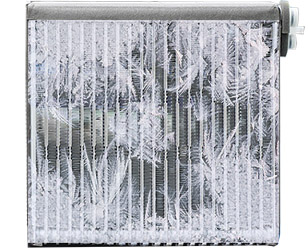
Refrigerant leak
A low refrigerant level in your Flex does not necessarily mean there is a leak. Ideally, the refrigerant should never leak in a properly sealed AC system, but most car AC systems do leak small amount of refrigerant over time due to minor imperfections and will need recharging after every few years.
If you don’t service the AC system in your Flex for a long time, the refrigerant level will eventually get so low that the system loses its cooling capacity and the airflow may also be restricted due to ice formation on the evaporator coil. Just have it refilled and you can drive with pleasant temperatures again. If the refrigerant level goes down again quickly, it means there is probably a leak.
Refrigerant leak causes
Refrigerant leak in Flex can be caused by leaking O-ring seals, leaking condenser or evaporator core, or a cracked hose. The leak can be diagnosed by injecting small amount of fluorescent dye into the AC system. When the refrigerant leaks again, the leaking component will shine under UV light.
How to recharge AC refrigerant in Ford Flex
There are two ports in the air conditioning system of Flex. One is labelled H for high-pressure and the other one is labelled L for low-pressure. You can recharge your AC through the low-pressure port with a do it yourself AC recharge kit.
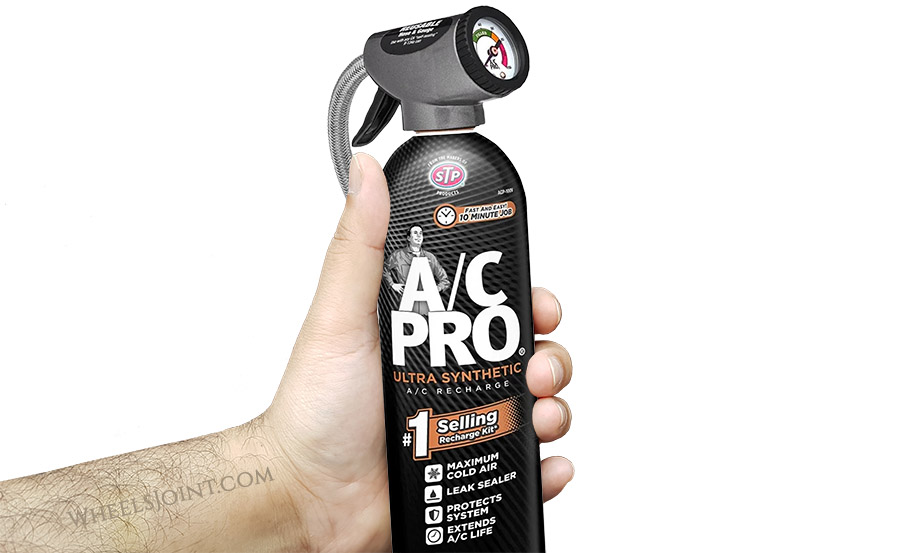
- Open the hood of your Flex.
- Check which type of refrigerant your vehicle uses. This information is typically located under the hood and/or in the owners manual.
- Start the engine.
- Turn on the AC and set it to the coldest setting, and the fan speed to maximum.
- Remove the cap from the low pressure service port labelled L, and connect the AC recharge kit.

Note: If the ports are not labelled, try connecting the recharge kit to both unlabeled ports on the AC hoses. The recharge kit will only properly connect to the low pressure port, and will not fit the high pressure port. - Shake the canister briefly and release the refrigerant into the system until the recommended pressure has been achieved.
Note: See next section for recommended pressure values.
Recommended video
Warning: Wear gloves and safety glasses before recharging the AC to avoid accidental exposure to harmful chemicals in the refrigerant. It is also cryogenic and can cause severe frostbite when it comes in contact with the skin.
Ambient temperature affect on refrigerant pressure
The refrigerant pressure is affected by the outside atmospheric temperature. If you recharge your Flex AC without accounting for ambient temperature, the system could over pressurize when the ambient temperatures get warmer.
Low side pressure values R134a vs R1234yf
| Ambient Temperature | R-134a | R-1234yf |
| 70°F (21°C) | 35-40 psi | 20-30 psi |
| 80°F (27°C) | 40-50 psi | 25-35 psi |
| 90°F (32°C) | 45-55 psi | 30-40 psi |
| 100°F (38°C) | 45-55 psi | 35-45 psi |
| 110 °F (43°C) | 45-55 psi | 40-50 psi |
Most modern vehicles use R-134a refrigerant, but newer vehicles are increasingly using R-1234yf as a more environmentally friendly replacement. The pressure values based on ambient temperatures differ depending on the type of the refrigerant. Check your vehicle’s owners manual or look under the hood to find the type of the refrigerant your vehicle uses.
4. Dirty blower motor
The blower motor is the central component of the air conditioning system in Flex, responsible for blowing hot or cold air through the AC vents. Although most of the dirt and other particles in the air are filtered by the cabin air filter, but some particles do escape and can cling to the fins of the blower cage. Over time dust can accumulate on the fins and reduce the airflow, which also reduces cooling performance.
If too much dirt is caked in the blower fins, it can throw off the balance of the spinning cage and cause it to wobble. This puts strain on the motor and further reduces the airflow and cooling performance, and may also cause unusual noises from behind the dashboard.
Clean the blower motor
Remove the blower motor, typically located under the passenger side dashboard, and inspect the condition of the cage. If found dirty, clean it using a brush.
Recommended video
5. Sluggish blower motor
If the blower motor in your Flex is not spinning fast enough either due to an internal defect or due to a fault in the resistor/control module, the airflow from the AC vents will be weaker and the cooling performance will be degraded due to reduced airflow.
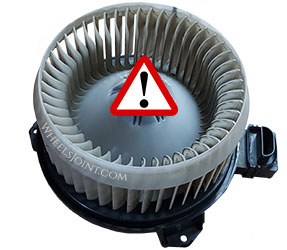
When a blower motor goes bad, it usually makes unusual noises when in operation, and the passengers may feel reduced airflow from the AC vents. Keep in mind that reduced airflow doesn’t always indicate a problem with the blower motor, as it can also happen due to a clogged cabin air filter, dirty evaporator, or a bad mode door actuator. So, all of them must be inspected when diagnosing poor airflow.
6. Faulty mode door actuator
The mode door actuator is part of the AC system in Flex which controls the airflow through different vents (front, floor or defrost) based on user settings. If this actuator develops a fault or goes out of calibration, the airflow may get divided between different vents resulting in reduced airflow from your desired vents.
For example if you have set the airflow from the front vents only, but the mode door actuator doesn’t fully divert the airflow to the front vents; the air is leaking from the floor or defrost vents. Just put your hand over the defrost vents on top of the dashboard to check if its leaking any air. If the air is leaking, replacing this actuator should resolve the issue.
Conclusion
There are many reasons why your Ford Flex AC is not blowing hard enough. When looking for the reason, you should always start with the most obvious cause, clogged cabin air filter.
In any case, it is advisable for laypersons to visit a workshop. A professional mechanic can swiftly diagnose the poor AC cooling issue for you.









